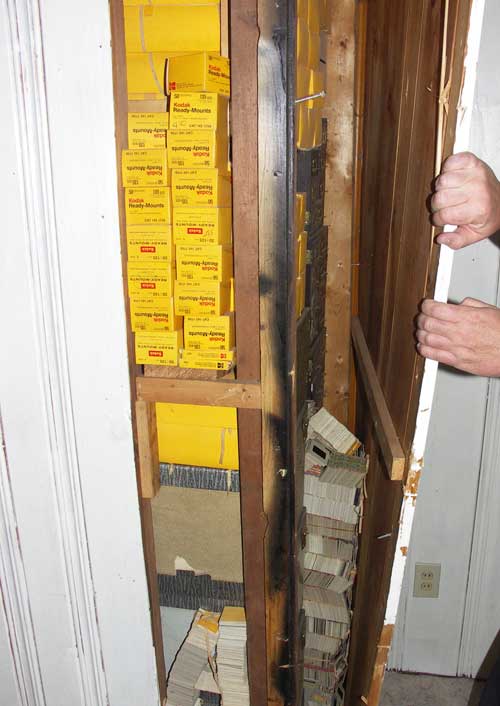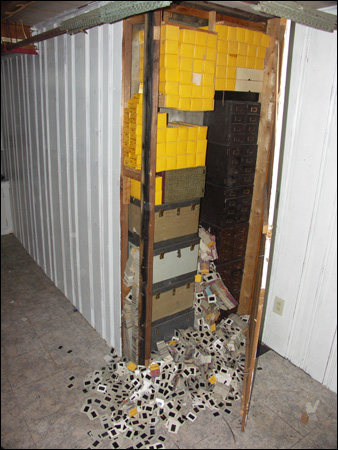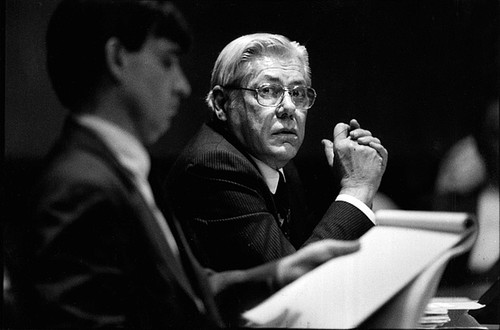By Hilary Waldman and Daniel P. Jones
Hartford Courant
December 2, 2007
http://www.courant.com/news/local/hc-reardon1202.artdec02,0,3227443.story
He says he can still see the huge Cadillac DeVille that slid up to his childhood home around lunchtime that Sunday 40 years ago.
In his memory, he is 12 years old again and can feel the terror as he climbs into the front seat next to Dr. George Reardon for a drive to St. Francis Hospital in Hartford.
Reardon's hair is slicked back, and he smells of smoke from the cigarettes that seem almost constantly pursed between his lips.
 |
| West Hartford police Wednesday announced that in May a homeowner on Griswold Drive renovating the basement found a large quantity - 50,000 35-mm slides and more than 100 8-mm video reels - of child pornography hidden in a secret storage area in the home, which was previously owned by Dr. George Reardon, a former chief of endocrinology at St. Francis Hospital and Medical Center in Hartford with a troubled history. |
And the boy, today a man, a father of four with a medical degree of his own and a career doing pharmaceutical research outside Boston, wonders when the West Hartford police will unearth the shards of his shattered childhood among the cache of pornographic photos found stashed behind a false wall in the basement of Reardon's former home.
The man, who asked to be identified only as Dr. C., is one of at least 80 people who have come forward to say that Reardon, once the chief of endocrinology at St. Francis Hospital and Medical Center, sexually molested them and took hundreds of photos of them naked when they were children.
Like Dr. C., many of the alleged victims were Reardon's patients. But at least a half-dozen others were children from the community whom Reardon recruited for so-called research studies about growth and development. Reardon allegedly drove those children to his hospital office and molested them there, too.
Some of the alleged victims told their stories in the 1990s, when the state moved to revoke Reardon's medical license and the doctor resigned from the hospital. Four patients had accused him of sexually abusing them during closed-door examinations in his office at St. Francis and on weekend trips.
Others came forward only last week, when West Hartford police announced that a homeowner renovating his basement at the Griswold Drive home formerly owned by Reardon discovered about 50,000 photographic slides and 100 movie reels containing pornographic images hidden behind wall panels.
For some, including lawyers who represented the alleged victims in administrative hearings before the state medical licensing board and later in a few lawsuits that resulted in modest settlements, the discovery solved a mystery that had lingered for four decades — what happened to all of those pictures Reardon took of his young patients in horribly embarrassing positions?
But for many alleged victims, including two interviewed in detail late last week, the find was cold comfort. Both of the men described abuse that took place in the 1960s when one was 6 and the other was 12. Both said they had always suspected that Reardon had buried the evidence someplace.
But both also said that Reardon's eventual resignation in disgrace, his death from heart and lung disease in 1998 and finally the proof that everything they remembered was true would not be enough to salve their pain. What they want — and fear they may never get — is acknowledgment from their parents that the doctor harmed them and that the children were not to blame.
"He was a person of authority, my parents treated him as a god," said Dr. C., who like several other alleged victims described his upbringing in a devout Catholic household. "My parents' philosophy was if something bad happened it was because God was punishing you."
The stories told by Dr. C. and by Tom, a 48-year-old married father of three who lives in Glastonbury, illustrate a pattern of abusing patients, mostly young boys but also some girls, that allegedly started when Reardon was at Albany Medical School in the 1950s and continued for the 30 years that he practiced at St. Francis.
According to Tom, his mother took him to see Reardon in 1964, after the boy suffered two seizures when he was 5. Reardon told Tom's mother to sit in the waiting room, that he would examine the boy alone. In the office, Reardon told Tom to undress and lie down on the examining table. He took a long look at the naked boy, stroked the boy's genitals for what seemed like a long time and told him to get dressed, Tom said.
Reardon then recommended admitting Tom to the hospital for tests. During 10 days in the pediatric unit doctors performed routine blood and brain testing during the day, Tom recalled. In the evening, a nurse would put Tom in a wheelchair and wheel him down a dark, quiet hallway to Reardon's private office.
 |
| Police are trying to identify victims pictured in a huge child pornography cache of slides and videos found at a home in West Hartford. |
When the nurse left, Reardon placed Tom on the Naugahyde examining table with the crinkly white paper cover and manipulated his genitals, Tom said. Always wearing his white doctor's coat, Reardon sometimes took photographs. Sometimes he did not. Once, there was another boy in the room when Tom arrived. Tom thinks that he, too, must have been a hospital patient because both boys arrived at the office wearing cotton johnnies. That time, a movie camera was set up on a tripod.
With the camera rolling, Reardon had the little boys pose as though they were performing anal intercourse, Tom said. Tom was too young to know anything about sex. He said he feared that something was so wrong with him that doctors were trying to change him from a boy into a girl.
When it was over, the nurse would return and wheel him back to his room.
"I used to cry every night for my mother to get me out of this place," Tom said. "I was clutching on to her and she said I had to stay."
At the end of 10 days, Tom was discharged and nothing more was said about Dr. Reardon or the stay at St. Francis. Tom grew into a man, established his own business, married, started his own family and surrounded himself with the trappings of success, including a large comfortable home and regular golf dates.
Then, in 1993 he returned home from a dinner date with his wife and casually picked up the newspaper. He was shocked to read a story about the state moving to revoke the license of a doctor accused of abusing children. One of the accusers, he read, had been Reardon's paperboy in the 1950s and committed suicide in 1978. His story sounded remarkably familiar. The memories, repressed for 30 years, came flooding back.
By the time Tom came forward, the state's case against Reardon was well underway. While he could not participate in state efforts to revoke Reardon's license, Tom filed a lawsuit against the doctor as an individual. When the case finally got to court, Reardon was weak and breathing only with the help of an oxygen tank. The doctor never appeared on the stand and Tom agreed to settle, accepting a modest monetary award from Reardon's estate after he died.
Tom's biggest regret is that his mother, now in her 80s, has yet to acknowledge his ordeal. His relationship with her, he says, has been strained since the incident. He also says he still resents the lawyers for St. Francis, who, he feels, seemed so bent on discrediting Tom that they never listened to his story.
Dr. C. managed to bury his encounters with Reardon until he turned 30 and had a son of his own. The memories returned in the form of recurrent nightmares.
But it wasn't the Sunday afternoon rides in the Cadillac that disturbed his sleep. Nor the hours he says he spent locked in Reardon's St. Francis office while the doctor fondled his genitals until it hurt and snapped hundreds of photographs, pausing only to reload the camera and smoke another cigarette.
It wasn't that Reardon acted like he had nothing to hide when he parked in the hospital garage and escorted Dr. C., then 12, into the hospital lobby, saying hello to the security guard as they passed. They rode an elevator up four or five floors. Inside the office, Reardon locked the door. "He said nobody can get in," Dr. C. recalled. "In my mind was, nobody can get out."
Terrified, he undressed, Dr. C said, and Reardon fondled him until he ejaculated. If that humiliation wasn't enough, he had to wait while Reardon cleaned him with a cloth. Then he took him to another room where a sheet was spread on the cold linoleum floor, and Dr. C. was told to pose in what must have been 25 contorted positions.
By the time the session was over, it was dark outside. Dr. C. was a studious boy, always interested in science. Before they left the hospital, Reardon walked him to a lab across the hall and gave him a few beakers and a flask to take home, a gift of real laboratory equipment, he said.
Dr. C. went back three more times, once alone, once with another boy whom Reardon picked up on the way to the hospital, the last time with two other boys. Reardon also posed Dr. C. with the other boys to look like they were involved in homosexual sex acts, Dr. C said.
But that's not what caused his nightmares either.
It was what happened when they got home that haunts him. Reardon walked the boy to the front door and sat down in the living room with Dr. C.'s parents. He told them that the session was very successful. And the boy worried that his parents would make him go back.
"It was reliving him telling my parents what a good job I did and me telling my parents I didn't want to go," Dr. C. said.
 |
| Dr. George E. Reardon, who died in 1998, listens to testimony in 1993 at the Legislative Office Building in Hartford that he had sexually abused a brother and sister. Photo by Michael McAndrews |
When the bad dreams started, he didn't trust his memory. For all of his adult life, Dr. C. has had trouble trusting anybody. He still jumps every time the phone rings. He has battled depression. He never knew why. There was a debate in his head — a doctor abused him, no he didn't. Not until the first allegations of sexual abuse by priests in the Boston area hit the papers, he said, did he realize that he wasn't crazy — he, too, had been victimized.
Dr. C. turned to drugs and alcohol to quell his demons. His marriage fell apart. By 1992 he was sober and ready to take action.
First, he ordered his medical records from the former Newington Children's Hospital, where he met Reardon in 1965. Dr. C. was 10 at that time, the smallest boy in his class, and Reardon specialized in childhood growth and development. The abuse did not start until two years later, Dr. C said, when Reardon discharged him from his care but asked him to participate in a growth study.
In 1992, when he found out that Reardon was still practicing at St. Francis, he filed a formal complaint with the health department in Connecticut.
"I decided if he harmed me, and I have a son, he could be harming kids right now," Dr. C. recalled.
Because of a legal technicality, Dr. C. never testified against Reardon when he was brought up on charges by the state Medical Examining Board. But during a break in one of the hearings, Dr. C. was able to face Reardon. Oddly enough, they were standing side by side in the men's room of a state office building.
"I just glared at him. He knew who I was," Dr. C. said. "I saw him and I faced him and I didn't dignify it by saying anything."
But it was enough, he said.
"Reardon kind of destroyed the child within me," said Dr. C., whose own children are now 17, 18, 20 and 21. He is remarried and successful, despite the ongoing depression. His children have helped him heal, he said, by allowing him to relive his lost childhood.
But one piece of his life remains unresolved — his mother's insistence to this day that everything that happened is his fault.
"My dream, my wish, is that my parents would accept what happened," Dr. C. said. "And accept me."
Contact Hilary Waldman at hwaldman@courant.com.
Any original material on these pages is copyright © BishopAccountability.org 2004. Reproduce freely with attribution.